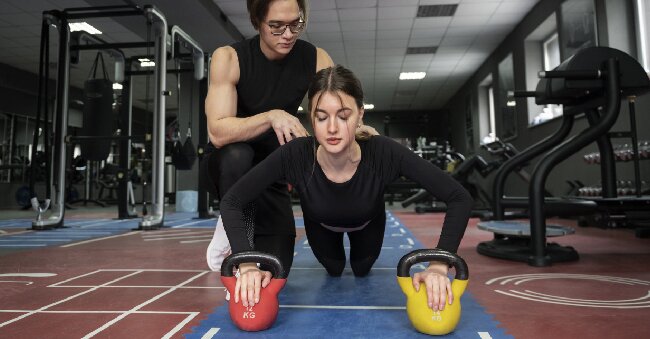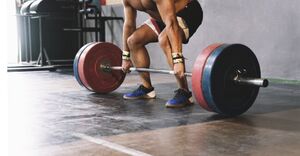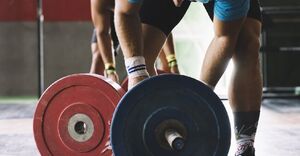
Kettlebell Training 101: 7 Essential Tips for Beginners to Master Your Workout
Looking to spice up your workout routine with something new and effective?
Discover kettlebell training! In this ultimate beginner’s guide, we will explore the world of kettlebells, from what they are and why you should incorporate them into your workouts.
Learn about the muscles they target, how to choose the right weight for you, basic exercises for beginners, safety tips, creating a workout routine, and common mistakes to avoid.
Level up your fitness game with kettlebells!
What Is a Kettlebell?
A kettlebell is a type of weight commonly used for strength training and fitness. It resembles a cannonball with a handle and offers a versatile way to work multiple muscle groups.
Its unique shape allows for dynamic movements that engage the core and stabilizing muscles, making it a popular choice among fitness enthusiasts. The off-center weight distribution of a kettlebell also improves grip strength and coordination. Compared to traditional dumbbells, kettlebells require more control and technique, leading to enhanced functional strength and endurance. Incorporating kettlebell exercises into your routine can help boost cardiovascular fitness and burn calories efficiently, making it a valuable addition to any exercise regimen.
Why Should You Incorporate Kettlebell Training Into Your Workout?
Incorporating kettlebell training into your workout routine can significantly enhance your overall fitness levels, providing a dynamic and engaging form of exercise that targets various muscle groups simultaneously.
Using kettlebells not only improves muscle strength but also boosts cardiovascular fitness, making it a well-rounded workout option for individuals looking to build endurance and power. The versatility of kettlebell exercises allows for the engagement of multiple muscle groups in each movement, promoting functional strength and coordination. The grip strength required to handle kettlebells further enhances overall physical performance and can help prevent injuries in various daily activities.
Versatility
One of the key advantages of kettlebell training is its versatility. It allows for a wide range of exercises that engage multiple muscle groups while improving technique and form.
Whether you’re a beginner looking to start with basic movements like the Swing and Clean or an advanced fitness enthusiast incorporating challenging exercises like the Snatch and Press, kettlebells offer scalability to suit all levels of strength and skill.
The dynamic nature of kettlebell workouts not only builds strength but also enhances cardiovascular endurance and flexibility.
Mastering proper technique is crucial to prevent injury and maximize the effectiveness of each movement, making it important to seek guidance from a certified trainer when starting out with kettlebell exercises.
Full-Body Workout
Kettlebell workouts offer a comprehensive full-body workout experience, engaging multiple muscle groups simultaneously for efficient and effective strength and cardio training.
This type of workout not only helps in sculpting your muscles but also aids in improving your overall cardiovascular endurance. Movements like squats and deadlifts performed with kettlebells activate the lower body muscles, leading to increased lower body strength and stability. Kettlebell swings, a dynamic exercise involving explosive hip hinge movements, work on the posterior chain, including the glutes, hamstrings, and lower back. The engagement of the core muscles in every kettlebell exercise increases abdominal strength, enhances posture, and helps prevent back pain.
Improves Functional Strength
Engaging in kettlebell training can lead to significant improvements in functional strength by activating and strengthening various muscle groups, enhancing overall muscle coordination and control.
This type of training involves dynamic movements that require proper muscle engagement, leading to increased muscle activation and recruitment. By performing kettlebell exercises with the right technique, individuals can experience improved strength and endurance. Incorporating varied sets and repetitions can challenge different muscle fibers, fostering muscle growth and development. Kettlebell training not only targets major muscle groups but also engages stabilizing muscles, promoting better balance and coordination. The emphasis on functional movements during kettlebell workouts translates to real-life benefits, helping individuals perform everyday tasks with greater efficiency and reduced risk of injury.
Time Efficient
Kettlebell workouts are known for their time efficiency, providing a potent combination of strength training and cardiovascular exercises in a shorter duration, making them ideal for busy individuals.
These dynamic workouts, often referred to as ‘Kettlebell Cardio‘, are a great way to enhance endurance while toning muscles. The beauty of kettlebell training lies in its ability to engage multiple muscle groups simultaneously, maximizing calorie burn and muscle development. By incorporating movements like swings, snatches, and cleans, a kettlebell workout offers a full-body challenge that keeps your heart rate up, saving you valuable time by eliminating the need for separate strength and cardio sessions. With regular practice, you’ll notice improvements in both strength and cardiovascular fitness, all in one efficient session.
What Muscles Does Kettlebell Training Target?
Kettlebell training targets a wide range of muscle groups, including the core, legs, back, shoulders, and arms, making it an excellent choice for a comprehensive full-body workout.
Engaging in exercises like Kettlebell Swings not only strengthens the core and legs but also works the glutes and lower back.
The explosive movements involved in Kettlebell Clean activate the shoulders, traps, and forearms while improving grip strength.
The dynamic nature of Kettlebell Snatch challenges the stabilizer muscles in the shoulders and engages the entire posterior chain, promoting functional strength and mobility throughout the body.
How to Choose the Right Kettlebell Weight for You?
Selecting the appropriate kettlebell weight is crucial to ensure you can perform exercises with proper technique and form, avoiding potential injuries and maximizing the effectiveness of your workout.
When determining the right kettlebell weight for your fitness level, it’s important to start with a weight that challenges you without sacrificing form. A general guideline is to begin with a lighter weight, especially if you’re new to kettlebell training.
As you become more comfortable and confident with your technique, gradually increase the weight to continue challenging yourself. Remember to engage your core, keep your back straight, and use a controlled motion during exercises to prevent strain and maintain proper form.
What Are the Basic Kettlebell Exercises for Beginners?
For beginners, foundational kettlebell exercises like the Kettlebell Swing, Goblet Squat, and Turkish Get-Up are excellent starting points to build strength and master basic techniques.
These exercises not only improve overall strength and conditioning but also help in enhancing stability and coordination. When starting out, it is crucial to focus on mastering proper form to prevent injuries and maximize effectiveness.
The Kettlebell Press is a great exercise for targeting the shoulders and triceps, requiring controlled movements and core engagement. Incorporating the Kettlebell Deadlift into your routine helps strengthen the posterior chain and teaches the importance of hip hinge mechanics. Structuring sets with these exercises can vary based on individual fitness levels and goals, allowing for gradual progression and skill development.
Kettlebell Swing
The Kettlebell Swing is a dynamic exercise that involves controlled swinging motions with the weight, engaging the hips, glutes, and core muscles for a powerful and effective workout.
One crucial aspect of mastering the Kettlebell Swing technique is the hip hinge mechanics. Keep your back straight and hinge at the hips while maintaining a slight bend in the knees. As you swing the kettlebell forward, focus on driving the movement from the hips rather than using your arms. Your arms should act as a guide, allowing the momentum generated from the hip thrust to propel the kettlebell forward.
This hip-centric technique not only maximizes the effectiveness of the exercise but also minimizes strain on the lower back. Proper core activation is essential to stabilize your body throughout the movement, protecting your spine and enhancing the power of each swing.
Goblet Squat
The Goblet Squat is a foundational kettlebell exercise that targets the legs, glutes, and core, promoting proper squatting mechanics and strength development.
To perform a Goblet Squat correctly, start by standing with your feet shoulder-width apart, holding the kettlebell close to your chest with both hands. Engage your core muscles and keep your chest up as you lower your body down by bending at the hips and knees. Aim to squat down until your thighs are parallel to the ground, ensuring your knees track over your toes. Remember to maintain a neutral spine throughout the movement to prevent injuries and maximize muscle engagement.
This Kettlebell Workout for Beginners is a great way to improve overall lower body strength and stability while focusing on proper form and safety.
Turkish Get-Up
The Turkish Get-Up is a complex kettlebell exercise that involves a sequence of movements to transition from lying down to standing up while holding the kettlebell overhead, challenging stability and coordination.
- The first step of the Turkish Get-Up begins with lying flat on your back, kettlebell in one hand while keeping the same-side knee bent.
- Engage your core and press the kettlebell towards the ceiling.
- Next, push off the ground with your opposite arm and foot, coming onto your elbow.
- From there, lift your hips off the ground, coming onto your hand.
- It’s crucial to maintain a strong wrist and shoulder position throughout to support the weight.
What Are Some Safety Tips for Kettlebell Training?
When engaging in kettlebell training, it is essential to prioritize safety by maintaining a secure grip on the handle, focusing on proper form to prevent injuries, and gradually progressing in weight and intensity.
- Ensuring a solid grip on the kettlebell handle not only enhances effectiveness but also reduces the risk of accidental slippage.
- Correcting form deviations such as hunching over or using improper posture can prevent strains and sprains.
It’s advisable to start with lighter kettlebells and gradually increase the weight and reps over time to avoid overexertion and strain on muscles and joints. Remember, safety always comes first in kettlebell workouts to maximize benefits and minimize the likelihood of injuries.
How to Create a Kettlebell Workout Routine?
Designing a kettlebell workout routine involves incorporating elements like a proper warm-up to prepare the body, a structured main workout focusing on specific exercises, and a cool-down session to aid in recovery and flexibility.
To begin with, a dynamic warm-up is essential to increase blood flow and raise the heart rate gradually, preparing the muscles and joints for the upcoming exercises. Incorporating movements such as arm circles, leg swings, and bodyweight squats can activate key muscle groups.
Moving on to the main workout, a Kettlebell Circuit offers a combination of strength and cardiovascular training, utilizing exercises like kettlebell swings, goblet squats, and Turkish get-ups to target different muscle groups effectively.
Following the intense workout, performing Kettlebell Mobility stretches can help improve flexibility and prevent muscle stiffness post-exercise.
Warm-Up
A dynamic warm-up before a kettlebell workout is essential to activate the core muscles, increase blood flow, and prepare the body for the upcoming exercises.
Engaging in exercises like high knees, arm circles, and hip openers can help improve Kettlebell Flexibility and mobility. Utilizing light equipment such as resistance bands or bodyweight movements can enhance the warm-up routine further. Incorporating dynamic stretches like leg swings and torso twists will not only promote proper circulation but also aid in Kettlebell Progression during the workout.
As you focus on warming up the body holistically, you set yourself up for a more effective and efficient kettlebell training session.
Main Workout
The main workout segment of a kettlebell routine involves performing a series of exercises with specific sets, repetitions, and rest intervals to target different muscle groups and achieve desired fitness outcomes.
To structure the workout component effectively, it’s important to choose a variety of dynamic exercises such as kettlebell swings, goblet squats, and Turkish get-ups that engage multiple muscle groups simultaneously. Aim for around 3-5 sets of each exercise, with 8-12 repetitions per set, focusing on maintaining proper form throughout. Rest periods between sets should typically range between 30-60 seconds to allow for adequate recovery while keeping the intensity high. This approach not only enhances Kettlebell Strength but also promotes muscle endurance and cardiovascular fitness.
Cool Down
The cool-down phase of a kettlebell workout focuses on stretching, relaxation, and gradual recovery, allowing the body to return to a resting state and promoting muscle repair and flexibility.
Incorporating stretching exercises into your cool-down routine post-kettlebell session is crucial for maintaining muscle flexibility and preventing stiffness the next day. Proper stretching helps in elongating muscle fibers, improving blood circulation, and alleviating muscle soreness.
Relaxation techniques such as deep breathing or meditation can aid in reducing stress levels and calming the nervous system after an intense workout.
Hydration plays a vital role in replenishing lost fluids during exercise, so remember to hydrate well during and after your kettlebell session.
Utilizing rest days is also essential for muscle recovery and growth, allowing your body to repair and adapt to the workout stress.
What Are Some Common Mistakes to Avoid in Kettlebell Training?
When engaging in kettlebell training, it is essential to avoid common mistakes such as using improper form, neglecting proper posture, lifting too heavy weights, and failing to warm up adequately to prevent injuries and maximize workout effectiveness.
Focusing on proper kettlebell mobility is key in ensuring a successful workout session. It is important to maintain a strong kettlebell mindset that prioritizes technique over intensity. Individuals should pay close attention to their body positioning throughout each exercise, making sure to engage the core and keep the spine neutral. Selecting appropriate weights that challenge but do not compromise form is crucial for steady progress and injury prevention.
By incorporating a thorough warm-up routine, participants can prepare their muscles and joints for the demands of the workout, ultimately leading to better results and reduced risk of strain.




No Comments